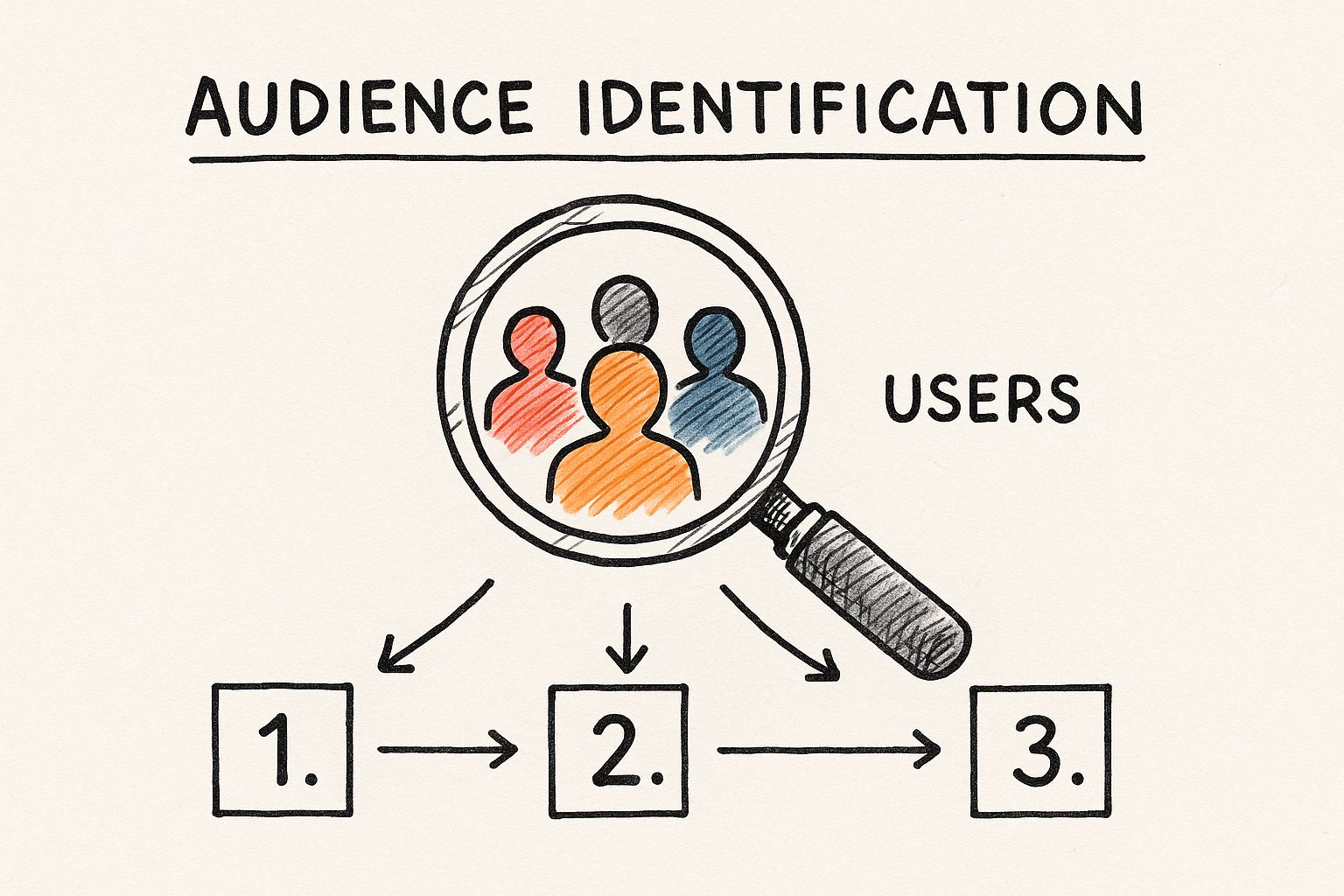July 25, 2025

Growing an online community isn't about chasing numbers right out of the gate. The real work happens before you ever send a single invite. It's about building a solid foundation first: defining your community's purpose, getting crystal clear on who it's for, and setting up a space that feels welcoming and safe. When you get this part right, you attract people who genuinely want to be there and are far more likely to stick around and participate.
So many people get this backward. They get excited, throw open the digital doors, and blast out invites, only to watch their new space become a ghost town in a matter of weeks. I've seen it happen time and again. The secret to sustainable, long-term growth is to flip that script. You have to build an incredible home before you ask people to move in.
Think of it like building a house. You wouldn't throw a housewarming party before the walls are painted and the furniture is in, right? The same logic applies here. This foundational work is what makes the difference between a thriving hub and a silent, empty forum.
First things first: what's the "why" behind your community? Without a clear, compelling reason to exist, people have no real incentive to join, let alone stay. Your mission is your North Star—it guides every single decision you'll make, from the content you create to the way you handle moderation.
To really nail this down, ask yourself a few key questions:
A well-defined purpose acts as a natural filter. It pulls in the people who are truly aligned with your vision and gently nudges away those who aren't a good fit.
Once you know your "why," it's time to figure out your "who." Creating an ideal member persona isn't just some fluffy marketing exercise; it's absolutely essential for building a community that feels personal and relevant. You simply can't be everything to everyone.
Go deeper than just basic demographics. You need to understand their mindset:
For instance, say your community is for "eco-conscious urban gardeners." Your ideal member might be a 30-year-old living in an apartment, frustrated by limited space but incredibly passionate about sustainability. Knowing this allows you to create discussions and share resources that speak directly to their real-world experience.
Key Takeaway: A community built for a specific "someone" will always beat a community built for "anyone." Specificity is what creates that feeling of connection.
Okay, with your purpose and ideal member locked in, it's time to get practical. Choosing the right platform is a huge decision. A tool like GroupOS is built specifically for professional networks, which is a game-changer because it brings memberships, content, and events all into one place. This avoids the clunky, disjointed feeling of juggling a Slack channel, a Facebook group, and an email list all at once.
Part of this setup is establishing clear community guidelines from day one. These aren't just a list of rules; they are the cultural bedrock of your community. They set the tone for respectful, productive conversations and are crucial for making members feel safe. Your guidelines should spell out what's encouraged (like sharing wins and giving constructive feedback) and what's not okay (like spam or personal attacks).
Taking this step seriously from the start is one of the biggest factors in member retention. In fact, research shows that brands with active online communities see a 53% higher customer retention rate. It’s a powerful reminder that positive interaction directly impacts business success. For more insights on this, you can explore more trends in community management from CreatorLabz.
Think of your community's content as the lifeblood of the group. It’s the campfire everyone gathers around. But just throwing logs on the fire—posting random content—won’t cut it. To really grow a thriving online community, you need content that crackles, sparks, and invites people to lean in closer. It's about moving away from a stiff, predictable schedule and creating a living, breathing rhythm of interaction.
This means you need to think beyond simple updates or announcements. Your content strategy should be built on a few core pillars that serve different member needs: providing real, tangible value, sparking fun conversations, and making your members the heroes of their own stories. This is the secret to turning passive lurkers into active, engaged participants.
Every single piece of content you share should have a clear "why" behind it. A balanced approach usually involves a healthy mix of educational, engagement-focused, and member-centric posts. This variety keeps your community feed fresh and ensures you're meeting members wherever they are on their journey.
Value-Driven Educational Content: These are the posts that genuinely solve problems. Think detailed tutorials, practical how-to guides, expert Q&A sessions, or breakdowns of complex industry topics. For a community of project managers, this might be a downloadable template for a risk assessment or a deep dive into a new software tool.
Fun Engagement Prompts: Not every post needs to be a serious lesson. Sometimes, the simplest, most open-ended questions can generate incredible conversations. For instance, asking "What's the best career advice you've ever received?" or "Share a photo of your workspace" can break the ice and let the unique personalities in your group shine through.
User-Generated Content (UGC) Campaigns: The ultimate sign of a healthy community is when your members start creating content for you. You can encourage this by running weekly threads like "Share Your Wins" or creating a specific hashtag for members to showcase their work. When you feature a member's post, you not only validate their contribution but you also inspire others to step up and share. It’s a powerful growth loop.

As you can see, truly understanding your members is the central point from which all effective content strategy radiates. Everything starts with them.
A content calendar isn't just a glorified to-do list; it's your strategic command center. When you use a platform like GroupOS, you can schedule posts well in advance. This frees you up from the daily scramble of "What do I post today?" and allows you to focus on what really matters: engaging in real-time conversations with your members. A great calendar balances your content pillars and incorporates different formats to keep things interesting.
My Personal Tip: Don't let your calendar become a cage. I always leave some breathing room for spontaneous, topical discussions. If there's breaking news in your industry, jump on it! This shows your community is current, relevant, and responsive to the real world.
The opportunity here is massive. With global users dedicating over 14 billion hours daily to social media, your community can capture a slice of that attention. This is where smart content planning really pays off. In fact, a Talkwalker report found that 73% of businesses see higher engagement rates when they use tools to help create more relevant and timely content.
To help you decide which content types to focus on, here's a quick comparison of common strategies.
This table breaks down a few content strategies to help you align your tactics with your community's goals.
Choosing the right mix from this table will depend on your community's current stage and what your members respond to most.
While text-based posts are the foundation, don't forget the power of video and live events. These formats create a much deeper, more personal level of connection. They allow members to actually see and hear you, which breaks down the digital barriers and builds trust far more quickly than text alone ever could.
Consider adding these powerful formats to your mix:
By digging into the performance metrics inside GroupOS, you can see exactly which content formats get the most traction. If your live Q&As have high attendance and tons of engagement, double down on them. If a particular type of educational post always gets a lot of comments, create a whole series around that topic. These data points are your roadmap to giving members more of what they love, which is the very essence of learning how to create a community that not only survives, but thrives.
An amazing community with nobody in it feels a lot like a great party with no guests. After you've built your foundation and have a content plan ready, the real work begins: bringing people in. But it's not just about filling seats. The goal is to attract the right people—the ones who will breathe life into your community and make it thrive.
Just randomly posting on social media and hoping for the best is a strategy that rarely pays off. Instead, you need a thoughtful plan that reaches your ideal members where they already are. Think of it as building bridges from their world directly into yours.
Before spending a dime on ads, it's smart to look at the assets you already have. The people most likely to join and engage are probably already connected to you in some way. They just need a clear invitation.
Your email list is your most valuable asset here. These folks have already raised their hands to say they're interested in what you have to say. I've found that a dedicated email sequence works wonders. Don't just announce the community—sell the transformation. Explain why you created it, highlight the exclusive value they'll get inside, and make them feel like they’re getting in on the ground floor.
And don't forget your social media followers. They follow you for a reason! Create engaging posts and stories that offer a peek behind the curtain. You could share a screenshot of an interesting discussion or a testimonial from an early member. A little FOMO (fear of missing out) can be a powerful motivator.
My Go-To Tip: Create a special incentive for your existing audience. It could be a unique "Founding Member" badge inside GroupOS or access to an exclusive Q&A with you. This small gesture rewards their early loyalty and makes them feel truly valued from day one.
To find new people, you need to put on your anthropologist hat. Where do your ideal members spend their time online when they aren't on your website or social media? The answer to that question is the key to your entire growth strategy.
Here are a few tactics that have worked for me:
The sheer scale of this opportunity is massive. There are over 5.22 billion social media users around the globe, which means more than 60% of the world's population is active on these platforms. Tapping into even a tiny fraction of that audience can fuel incredible growth for your community. And since platforms like Facebook and Instagram continue to deliver some of the highest ROI for marketers, focusing your efforts there can be a really effective move. You can dig into more social media statistics from SocialBee to help you decide which platforms make the most sense for you.
Think of your community's landing page as its digital front door. It needs to do more than just describe what's inside; it has to clearly communicate the value and make visitors eager to step through.
A high-converting landing page should always include:
This is also the perfect place for a lead magnet. Offer something incredibly valuable for free, like an ebook, a mini-course, or a template library, in exchange for an email address. This lets you capture leads who are interested but might not be ready to join today. From there, you can nurture them with helpful emails and eventually invite them to become active, paying members.
Getting new members is a great feeling, but that's just the starting line. The real win—and the key to sustainable growth—is keeping those members around, getting them to participate, and making them feel like they truly belong. Without engagement, all you've built is a digital ghost town. It might look populated, but it's eerily quiet. Your job is to become a master of daily engagement, transforming those quiet lurkers into the active, core contributors who are the lifeblood of your community.
This is how you build a self-sustaining ecosystem. It's an environment where members don't just consume content; they actively create it, answer each other's questions, and welcome newcomers with open arms. This doesn’t just happen on its own. It's the direct result of your intentional, consistent efforts as the community leader.

One of the easiest ways to get people talking is simply to ask them something. But there’s a trick to it. Closed-ended questions that get a simple "yes" or "no" are conversation killers. Instead, you need to use open-ended prompts that practically beg for stories, opinions, and personal experiences.
For example, instead of asking, "Did you enjoy the webinar?" try this: "What was your single biggest takeaway from yesterday's webinar?" That small change encourages a much more thoughtful response and opens the door for follow-up discussions among members.
Here are a few types of questions I’ve seen work wonders:
That last one is pure gold. When you show a little vulnerability as a leader, you make it safe for others to do the same. This is how you cultivate a culture of genuine, mutual support.
Consistency is the secret ingredient to building habits. Community rituals—those recurring events or threads members can count on—give your group a predictable rhythm. These scheduled touchpoints encourage people to log in and participate as part of their regular routine.
Think about establishing a few weekly or monthly rituals that fit your community's purpose. For instance, a group for photographers could do a "Macro Monday" for sharing close-up shots or a "Feedback Friday" for constructive critiques.
My Two Cents: Rituals are what turn passive membership into an active habit. When members know there’s a "Weekly Goals" thread every Monday, they’re far more likely to show up and contribute, creating a self-perpetuating cycle of engagement.
With a platform like GroupOS, you can schedule these posts well in advance. This ensures your rituals happen like clockwork, even when you’re swamped, freeing you up to focus on what matters most: replying to comments and deepening the conversations.
Let's be honest: people stay where they feel seen and valued. One of the most powerful things you can do is to publicly celebrate your members' contributions. When someone shares a big win, offers incredible advice, or helps out another member, put a spotlight on them. A simple "@ mention" saying, "This is fantastic advice, thank you for sharing!" can make a member's day and reinforce positive behavior.
This kind of recognition accomplishes two things at once:
But don't stop at shout-outs. Look for opportunities to truly empower your most active members. You can spot these future leaders by keeping an eye on activity inside GroupOS. See who consistently gives helpful answers or kicks off great discussions.
Once you’ve found them, give them more ownership. Invite them to host a Q&A session, grant them a special "Community Expert" badge, or even ask them to become a moderator. This not only lightens your load but also gives your most passionate members a deeper stake in the community's success. Exploring other powerful member engagement strategies can also help keep your community buzzing with positive interaction.

If you're not measuring your community's health, you're flying blind. When you're just starting, you can get by on gut feelings. But as you grow, relying on intuition alone just won't cut it. To scale thoughtfully, you have to lean on data.
It's easy to get caught up in the big, shiny number: total members. But that's a classic vanity metric. Sure, it feels great to watch it climb, but it tells you almost nothing about how healthy or engaged your group actually is. A community of 10,000 silent lurkers is a ghost town compared to a vibrant group of 500 people who are actively connecting and contributing.
The real story of your community is told through metrics that reflect genuine interaction. These are the numbers that show you who's talking, what they're talking about, and whether they're sticking around. Focusing on these Key Performance Indicators (KPIs) is the secret to learning how to grow an online community that actually lasts.
Your first step is to build a simple dashboard. This doesn't have to be fancy—a basic spreadsheet works perfectly fine. The goal is to track a few core health indicators every week or month. This rhythm will help you spot trends, catch problems before they blow up, and find hidden opportunities.
Here are the metrics I always keep an eye on:
Tools like GroupOS are fantastic because they're designed for this. The platform gives you analytics that track these crucial engagement numbers right out of the box, saving you a ton of manual work.
Don't overcomplicate your dashboard. Consistency is what matters. When you track the same metrics over time, you create a baseline that makes it incredibly easy to see what’s working and what’s falling flat.
Here’s a simple way to structure it:
Reviewing this data regularly will start to directly shape your strategy. For instance, if you notice that member spotlight posts get 3x more engagement than anything else, that's a crystal-clear sign to make them a weekly feature.
Pro Tip: Don't just stare at the numbers; look for the story in the trends. Is your active user rate starting to dip, even slightly? That’s an early warning that your content might be getting stale or that you need a new engagement initiative.
As your community gets bigger, this data becomes your roadmap for scaling without breaking the culture you’ve built. The insights you gather help you make smarter, more intentional decisions about everything from content planning to moderation.
Imagine your comment-to-post ratio starts to drop as a flood of new members joins. This could mean newcomers feel too intimidated to speak up or that the main feed is getting too noisy. With that data point, you can take targeted action. For a closer look at which numbers to track, our guide on essential community engagement metrics breaks it all down.
For example, you could:
This is how you move from a reactive, guessing game to a proactive, strategic approach. It’s how you ensure that as you scale, you’re not just adding more people—you're strengthening the heart of your community.
As you get into the weeds of building your community, questions are going to pop up. It's totally normal. The path isn't always straight, but that's what makes it rewarding. Let's tackle some of the most common questions I hear from community builders just like you.
Everyone wants to know the magic number for growth, but honestly, there isn't one. How quickly your community grows really depends on your niche, how you're promoting it, and the time you're putting in.
A good rule of thumb? Expect to spend the first 3 to 6 months laying a really solid foundation. Your goal here isn't to hit 10,000 members overnight. It's about nurturing a small, core group of "founding members" who are genuinely excited to be there. These are the people who will set the tone for everyone else.
Real, organic growth usually starts picking up steam after that six-month mark. By then, your culture is starting to form, and you'll see that magical word-of-mouth effect begin to kick in. Just remember, consistency is everything. If you only show up sporadically, your progress will grind to a halt.
I've seen so many enthusiastic community builders stumble into the same traps. If you can sidestep these common pitfalls, you’ll save yourself a ton of headaches and get on the fast track to a thriving group.
Here are the biggest mistakes to watch out for:
It’s worth remembering that customers genuinely spend more after joining a brand's community, as a University of Michigan study found. But this only happens when the community is built around providing real value to the members.
This is the million-dollar question, and the answer comes down to one thing: your primary goal. There’s no single "right" answer here, only what's right for what you're trying to achieve.
A free community is a fantastic way to build brand awareness at the top of your funnel. It's perfect for casting a wide net and attracting the largest possible audience, often serving as a powerful lead generator for other paid products or services.
On the other hand, a paid community changes the dynamic entirely. When people pay, they have skin in the game. They're more invested, more likely to participate, and more committed to getting value. This model also creates a predictable revenue stream you can use to improve the community itself.
A lot of creators I know land on a hybrid model. They might have a free, public group to build buzz, with a paid, premium tier that unlocks exclusive content, direct access to experts, or other special perks.
To decide, ask yourself this: am I aiming for mass reach (go free) or deep commitment and direct revenue (go paid)? Your answer to that question will shape your entire strategy.
Ready to build, manage, and scale your online community without juggling a dozen different tools? GroupOS is the all-in-one platform that brings your memberships, content, events, and communication into a single, beautifully branded hub. Start your free trial and see how easy it is to grow a thriving community.


